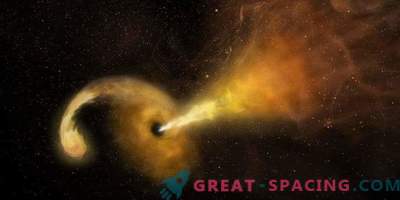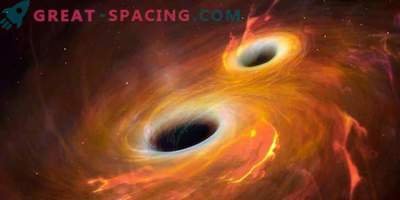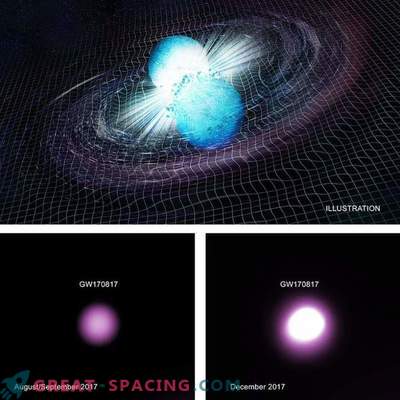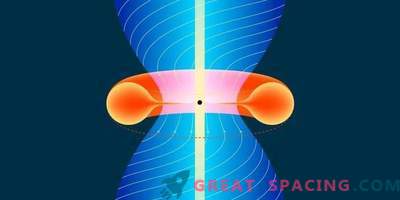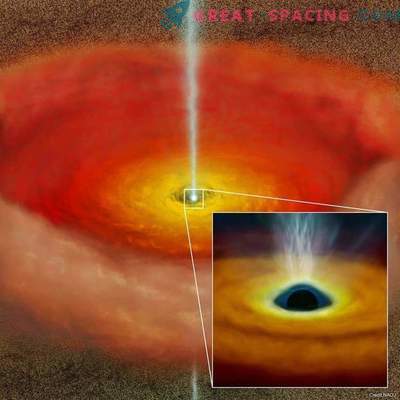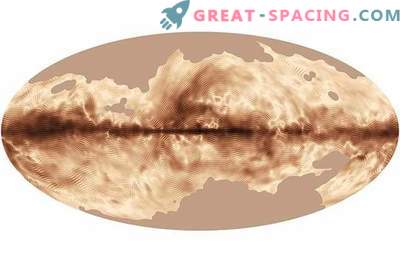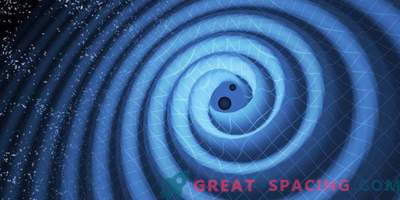
Artistic vision of the internal flow of accretion and a jet from a supermassive black hole during the period of active feeding (for example, from a recently exploded star)
On November 11, 2014, the global network of telescopes received signals from a distance of 300 million light years. The event was an explosion of electromagnetic energy that occurred when a black hole bursts an approaching star. The study made it possible to learn more about how black holes absorb matter and regulate galactic growth.
Recently, researchers from the Massachusetts Institute of Technology and Johns Hopkins University have identified radio signals from an event that is closely related to X-ray emissions from the same outbreak 13 days ago. They believe that these radio emissions (90% similar to X-rays) do not protrude by chance. Most likely we are facing a giant jet of high-energy particles flowing from a black hole absorbing stellar material.
Models show that the black hole's feed rate controls the force of the jet being created. If the hole is full, the jet will be powerful and vice versa. This is an important point, as we first recorded a jet stream controlled by the power of a supermassive black hole.
Scientists have long suspected that jets of black holes are fueled by the accretion rate, but no one could observe this connection in a single event. This is possible only if the black hole is calm and a star appears next to it, which will give away a huge amount of fuel, triggering activation.
Discussion
Based on theoretical models of the evolution of black holes and observations of distant galaxies, researchers understand what happens during a tidal destruction event: when a star approaches a black hole, the gravitational pull of the latter creates tidal forces.
But the gravity of a black hole is so powerful that it can destroy a star by stretching and flattening it. As a result, the star turns into rain from debris that falls on the accretion disk.
This whole process creates colossal energy bursts along the EM spectrum, which can be observed in the optical, UV and X-ray poles. The X-ray source is considered ultracold material in the innermost areas of the accretion disk. Optical and UV rays appear from the material left on the disk, which is drawn into a black hole.
The researchers knew that radio waves are generated from extremely energetic electrons. But the controversy continued about where these kinds of electrons come from. Some believe that at the time after the stellar explosion, the shock wave propagates outward and activates plasma particles in the environment. In this scenario, the picture of the emitted radio waves will be radically different from the X-rays. It turns out that the find defies the paradigm.
A moving pattern
Scientists looked at the 2014 outbreak, recorded by the ASASSN telescope network. The event was called ASASSN-14li and monitored radio data for 180 days. They managed to find a clear resemblance to the patterns that were previously observed in the X-ray information of the same event. Moreover, the similarity reached 90%. The same fluctuations in the X-ray spectrum appeared after 13 days in the radio band. It is believed that the only method of binding is the physical process. The analysis also showed that the size of the X-ray emitting area is 25 times larger than the solar, and the radio-emitting area is 400000 times larger than the solar radius. Such a discrepancy indicates the presence of a causal connection between a small area with X-rays and a large one with radio waves.
The team believes that the radio waves were created by a jet of high-energy particles that began to flow out of the black hole shortly after the absorption of the stellar material was activated. Due to the density of the jet region, most radio waves are immediately absorbed by other electrons.
Only when the electrons moved downstream from the jet did the researchers capture this signal. As a result, it turns out that the jet force must be controlled by the accretion rate (the speed with which the black hole absorbs star debris).
The results will help to better understand the physics of the behavior of the jets, which will affect the understanding of the galactic evolution.

